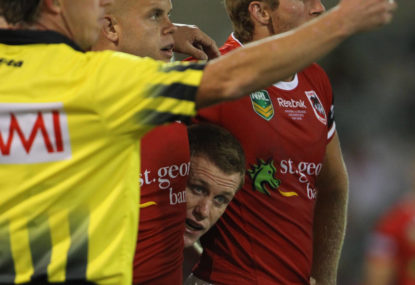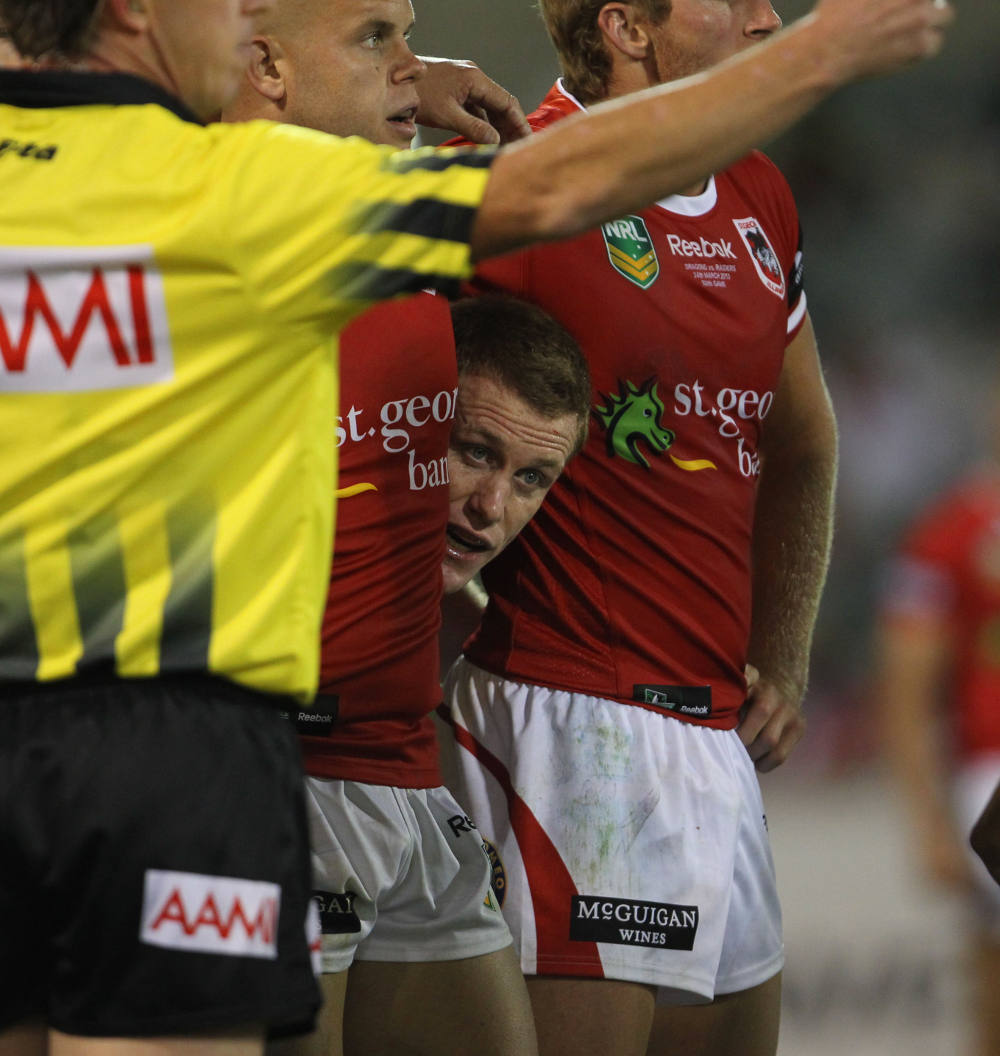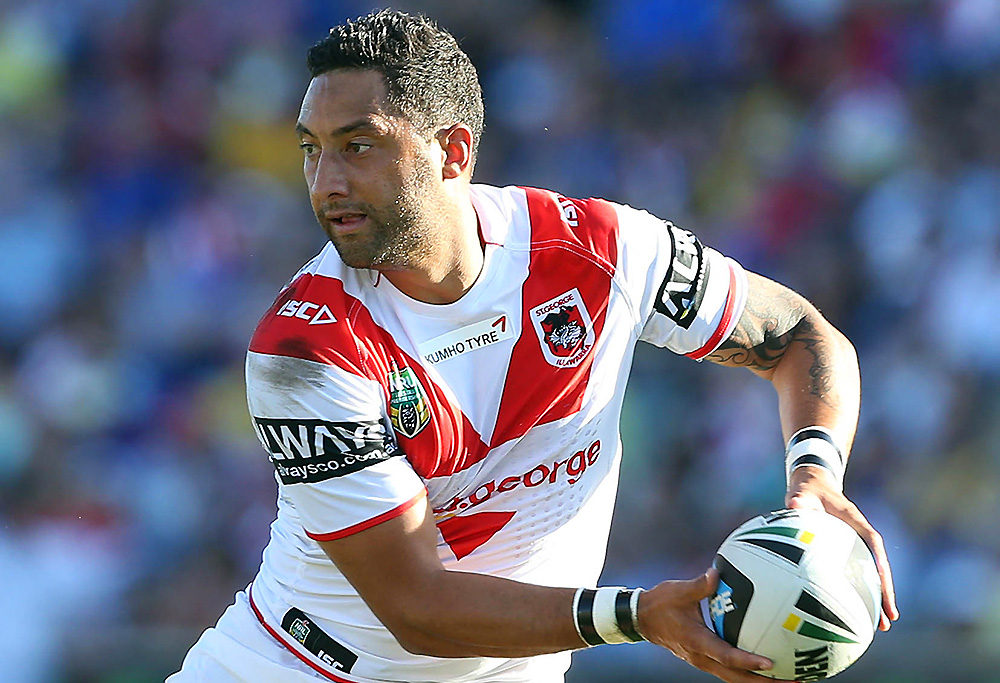NRL Round 7 judiciary: Roosters star duo charged
James Tedesco will be free for the next game of the Sydney Roosters' inconsistent NRL campaign after escaping suspension for tripping Ryan Papenhuyzen. The…

When Ben Creagh first came to the Dragons out of Wollongong in 2003 he was an 18-year-old winger.
Nathan Brown was a 30-year-old first year coach when he mused to his mate Mark Gasnier: “This bloke will play for Australia… in the backrow.”
Gasnier laughed at him. Yeah, sure mate. But Brown was serious.
Two years later Creagh played for Australia – in the backrow. Because he possessed the holy trinity: He had size, speed and power.
You can understand the appeal of these people. Behemoths are good. But surely rugby league is missing out on people. Namely that ever-diminishing style of player – the footballer.
Not to say blokes don’t have the ability to become ball-playing locks. Bryce Cartwright is a big No.6, if you like.
But the way the game is coached and played – the NRL way when ‘winning’ is all that counts – when coaches and recruitment types have the choice between two players to play No.13 – on the one hand Tyson Frizell, the other Tyrone Peachey – the Peach is second best every time.
Because if you can get 60 minutes out of the Incredible Hulk, he’ll change the game. But a skinny kid, freakish ability – say Bevan French, Will Smith – they’re not the shape of what you need and clubs will buy the other bloke first.
The game rewards it.
The greatest game of all rugby league evolves quickly. Like those fish that emerged from the primordial swamp to breathe oxygen and later walk and talk and drive around in late model sedans, rugby league players adapt to their environment.
And so today they have giant legs and high speed and flick passes, and are more than one man.
Rugby league players’ body shapes, athleticism, speed, power, skills, fitness, just about everything, have adapted to each change in the game.
Even the little rule changes have a flow-on effect as sharp-eyed players and coaches look to exploit each little nuance of the contest.

Digital image by Colin Whelan © nrlphotos.com
Consider head knock laws – if you can convince the bloke sideline you need a concussion test, and pass it (because you’re not concussed) your team gets a ‘free’ interchange. It happens. It’s understood.
The interchange and to a lesser extent the de-powering of the scrum is why rugby league has crawled out of the swamp and given us the sometimes gob-smacking athletic spectacle it is today. But the nomenclature for what people do needs an upgrade. We still have ‘hookers’ and ‘second-rowers’ but it’s nothing to do with their job description.
Now, not to lament the good old days because they often weren’t, and scrums were a dog’s breakfast and there were penalties from scrums that decided games, and people hated them.
But there was a time forwards contested scrums and grew tired. And this was no bad thing.
There was a time centres stood next to one another, as they do in rugby union and there’d be a big long shift and cries of “Spin it wide!”.
And they’d pair the centres depending on their body shape. Steve Ella could play inside-centre; Andrew Farrar and Gene Miles outside-centre. That’s how they picked them – little one inside bigger one.
Today they’re pigeon-holed left or right, and apart from Peachey and Jarrod Croker at a pinch, there are no little ones.
They are mostly if not all behemoths.
There was a time everyone was Peachey. The silky-skilled Penrith ‘utility’ man is shaped how they used to be: a skilful, fit though otherwise a normal human being.
There was a time the only freaks were Mal Meninga and Paul Sironen.
There was a time when Allan Langer was the scariest man on the field because he could spot a tired forward from a thousand yards, and exploit him.
Today the Cowboys take off Jason Taumalolo and replace him with, effectively, Jason Taumalolo, another giant thunder man whose gig is to run over the other mob’s premium play-maker; and seek to destroy him all game.
The game has gone down a path based on coaches’ structure and lost a lot of what you’d call ‘natural’ footballers.
Once clubs started to recruit on body shape, fitness tests, physique, strength, and almost went the American football model of testing speed, agility, they stereotyped guys based on these numbers into a position.
Back-rowers weren’t always six foot four, 130 kilograms with certain skin-folds, beep test numbers. They didn’t have to achieve all these certain targets. Arthur Beetson would never have been picked.
The interchange and de-powered scrum means the physical, fast, 20-minute ‘athlete’ is much in vogue. Many would like the interchange wound down or even disbanded to bring the back the ‘natural’ footballer.
Coaches are unromantic, cynical, hard. They care not for frippery. Well, you can frip about all you like. Frip away, as long as it contributes to the winning of games.
Benji Marshall was the game’s foremost frip merchant. But the ‘W’ column was all-important. Entertainment is okay as a by-product. But as many a sacked coach will tell you, “Winning isn’t everything, yes it is.”

(AAP Image/Action Photographics, Robb Cox)
There’s a theory among the game’s thinker that ‘The Wrestle’ would be non-existent if the game got rid of the interchange system. That players would be too fatigued.
But then there’s that theory of evolution again. Players will adapt and overcome.
Might the NRL one day brush the interchange? Who knows what these people are thinking? They have committees to decide on who’s in committees.
Bottom line is there has to be reward system for the smaller player. Preston Campbell won the Dally M Medal in 2001.
That was the year league first saw wrestling, gang-tackling, slowing down the ruck. The interchange was getting worse and they were recruiting certain body shapes.
Rugby league like the game of life needs to find a balance that rewards smaller players later in the half, the back end of 80 minutes.
The little man has to wear big blokes running at them all game. Think of Kodi Nikorima or Shaun Johnson – brilliant players, hot on their feet. They have behemoths thundering at them for 80 minutes, no respite.

(Photo: www.photosport.co.nz)
That little bloke should have the right, later in the half, after these big blokes have run at him all day, to say, “Okay, let’s see how fit and nimble you are now. Take you on back through the middle”.
It’s what made Alfie Langer, Ricky Stuart, the silky Greg Alexander. They were too smart. Alfie could pick out a lumbering forward from a thousand yards.
Cameron Smith has a little pet play in which he angles to the left, drags them over, grubbers hard back cross field for the in-goal, where Cooper Cronk is flying.
Cronk is a freak, as Thurston and Smith are freaks. People run at these people all game and they’re still able to conjure the magnificent.
But they’re the exception to the rule.
And the game is lesser for it.